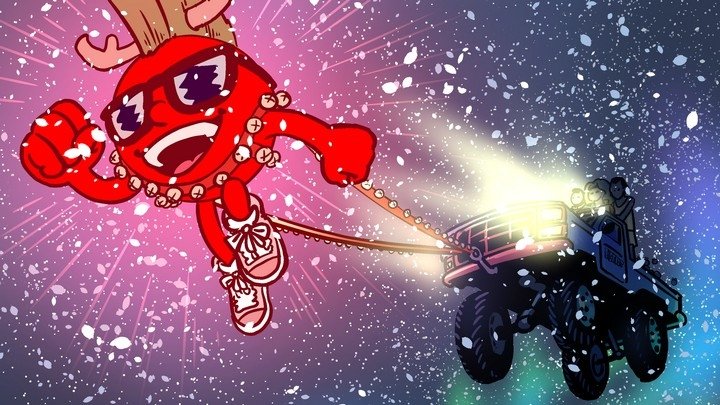Embarking on a Strange Journey, redux
Development director Eiji Ishida discusses the creation and recreation of Shin Megami Tensei: Strange Journey
One of the most engrossing role-playing games ever to appear on Nintendo DS—Shin Megami Tensei: Strange Journey—recently reappeared on 3DS through one of the best remakes we've seen in recent memory. Strange Journey took the franchise back to its early roots by shifting the play style back to the dungeon-crawler format and placing a heavy emphasis on combat. At the same time, of course, it still feels very much a part of the SMT franchise, mingling sci-fi military drama with the series' demons and morality.
We recently passed along some questions about both the remake and the original Strange Journey to director Eiji Ishida, and he's offered some fascinating insights into the game's origins, the team's hopes for future games in this style, and even some spiritually similar Hollywood fare.
Retronauts: How involved with this remake has the original development team from the DS version of Strange Journey been?
Eiji Ishida: I served as director of this game, just like I did for the original. Several dungeon level designers and graphic artists also came back. On top of that, the original sound effect staff returned, and the composer, Shoji Meguro, even created new songs.

Retronauts: Strange Journey took SMT back to the style of the older games with its first-person dungeon-crawling. What sets Strange Journey's take on this format apart from peers like Etrian Odyssey and Persona Q? In other words, why should newcomers give it a look despite the presence of so many other Atlus RPGs in this vein on 3DS?
EI: This game’s development began using the Etrian Odyssey game engine, so there are quite a few similarities stylistically. However, we weren’t focused on differentiating this game from Etrian Odyssey and other titles while we were working on it. If anything sets this game apart in that respect, I would say it is the result of our pursuit of an “experiential” theme that is unique to this title.
The player assumes the role of an expeditionary force member, charged with investigating a spatial phenomenon called the Schwarzwelt that has appeared in Antarctica. To carry out your mission, you must set foot in this perilous area overrun with demons that were supposed to exist only in legend. The “experiential” theme derives from two things: exploration in order to unravel the riddle of that dimension and confrontation with the demons that impede you.
As for the former, we took a classic, dungeon-crawler core and imbued it with an additional level of immersion. For example, Strange Journey Redux’s scanning system allows players to analyze discoveries and mysteries while in the field, further immersing players in the role of a task force member and providing them the joy of taking control of their environment. I believe these elements create an experience that is wholly unique.
If I was asked why people should choose Strange Journey Redux from among other Atlus titles in a similar vein, I suppose one reason is because its story encapsulates multiple genres. It is a heady brew containing influences from the deep sci-fi series we were into at the time, like Battlestar Galactica and LOST, plus we mixed in action, suspense, horror, the occult, sometimes even comedy and other ingredients. We ended up with quite a concoction, and it gives players the opportunity to experience a wide variety of narratives.
Retronauts: Strange Journey was already an incredibly lengthy game, and you've added more material to this remake. What does the new material add to the experience? Have you rebalanced the game in any way to ensure the additional content doesn't slow down or protract an already time-consuming journey?
EI: We thought that players who have already experienced the original game needed some new challenges, so we’ve added a new dungeon, a new story arc to go with it, and new characters. The new story branches into three new endings, so I believe there is a lot of new content to play. Without getting into spoilers, I think that people who’ve played the previous installment will find the motivations of the new key character to be quite shocking and fascinating.
As for improvements over the original game, to increase immersion, we’ve drawn illustrations for nearly all characters that lacked bust-up portraits in the original. We’ve also added voices to these characters, done by voice talents known for their animation and movie dub works, making the scenes feel more dramatic. I believe these changes enhance players’ feeling of engagement with the story.
As for game systems, we’ve added many combat skills to expand the abilities of the protagonist commanding the demons, and considerably increase the tempo of combat. The U.I. has been overhauled to reduce the number of button inputs that players need to enter. The ability to sprint in a dungeon has also been added, as well as various small improvements, for the whole purpose of increasing the pace of the game.
You’d have to compare them side by side to notice it, but once you get your hands on the remake, there are so many quality-of-life improvements that you’ll find it hard to return to the original game.
We’ve also added the ability to change the difficulty, so players can further increase the pace of the game by setting it to Easy. Finally, I believe that the ability to save your game in the field is a major point of improvement. It should greatly minimize the loss of having to retry when your party is wiped out.

Retronauts: I've heard rumors that Strange Journey was originally intended to be published as Shin Megami Tensei 4, but was turned into a non-numbered spinoff instead. What do you think defines a "true" SMT game? In your opinion, where does a spinoff like Strange Journey fit into the franchise or universe?
EI: To be exact, it was developed as a spinoff from the start. The promotional staff at the time judged the game to have high enough quality to be marketed as a numbered title, so they suggested selling it as a numbered SMT game. Even Mr. Kazuma Kaneko, who worked with us to design the human and demon characters and pen the original story, backed up the suggestion, saying it was “good enough to be called Shin Megami Tensei IV.”
But, because it was conceived as a spinoff, we enjoyed the freedom of going off on a tangent from the mainline games (and the extra pain and suffering from that, haha). Therefore, I felt a strong resistance to market it as a numbered title, and I ultimately rejected the suggestion. I think I would be a little more flexible about it now, but my past self who had just experienced the pain of creating a new title wasn’t as confident, and I couldn’t make that decision then.
On that note, Strange Journey has no chronological relationship to the rest of the Shin Megami Tensei series.
Retronauts: Why remake a relatively recent game like this, rather than creating a sequel?
EI: We decided to remake Strange Journey to make it more widely known. We would like to consider a sequel, and we actually have ideas for the story and a new game experience. Whether we can make it happen, though, depends on how well this game performs.
Retronauts: Not totally game-related, but what did the team think of the movie Annihilation? It has an incredibly similar premise to Strange Journey...
EI: I loved Alex Garland’s previous film Ex Machina, so I was also looking forward to Annihilation.
As you point out, the setting, storyline, ending with reverberations that cause the audience to imagine a world that has ended, and other elements feel similar between both titles. (Ouroboros even showed up.) They are both stories about a journey that takes place in a strange land.
I was captivated by the Shimmer which evoked terror as well as peace and beauty, and the way that the characters had dual aspects to their personalities. It was very much my type of movie. I've read that the original novel left threads open for a possible sequel, but the film wrapped up the story so nicely in a resonating way, my personal preference would be to not have a sequel. (Of course, if there is a sequel then I’ll see it right away, haha.)
By the way, Maaya Sakamoto, the voice actor of Zelenin in Strange Journey Redux, was the Japanese dub actress for Natalie Portman in Annihilation. In that sense too, I feel a strong affinity with the movie. She is the exclusive dub actress for Natalie Portman in Japan, and also the Japanese voice of Aigis in our Persona series. I especially love her dub work for Fiona in the TV drama Shameless!
Although Ms. Sakamoto plays many characters, to think she’s the voice of both Aigis and Fiona... it’s just incredible!
Thank you so much for your interest in Strange Journey Redux. It would make me so happy if this interview gains us even one new fan.




